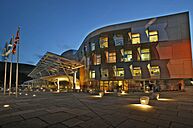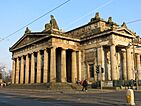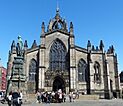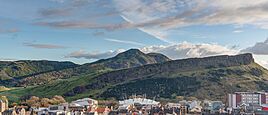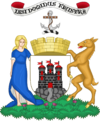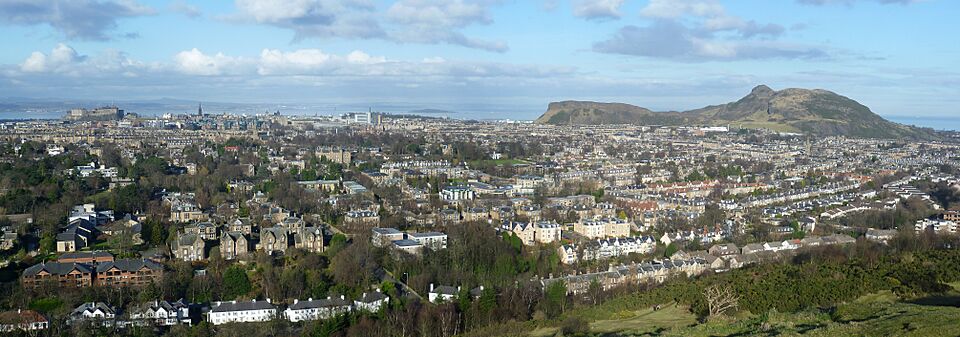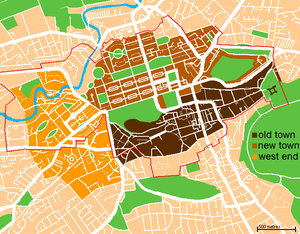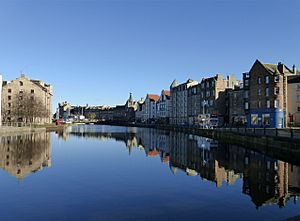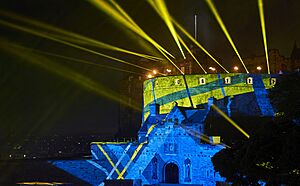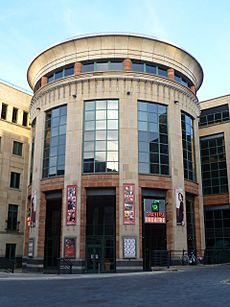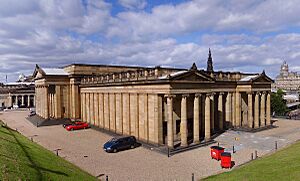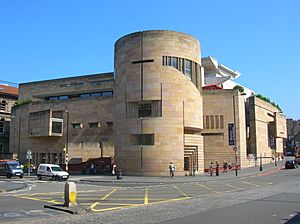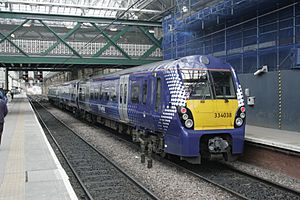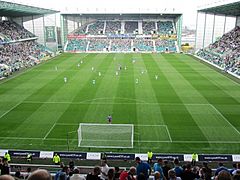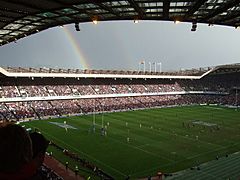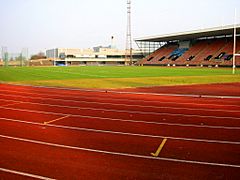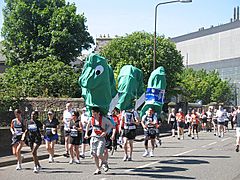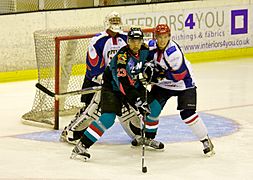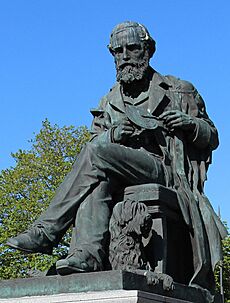Edinburgh facts for kids
Quick facts for kids
Edinburgh
Dùn Èideann (Scottish Gaelic)
|
|||||||||||||||||||||
|---|---|---|---|---|---|---|---|---|---|---|---|---|---|---|---|---|---|---|---|---|---|
|
Capital city, lieutenancy and council area
|
|||||||||||||||||||||
|
Skyline of Central Edinburgh, with the Dugald Stewart Monument (forefront) and Edinburgh Castle (background)
Scottish Parliament building
Royal Scottish Academy Building
|
|||||||||||||||||||||
|
|||||||||||||||||||||
Nickname(s):
|
|||||||||||||||||||||
| Motto(s): | |||||||||||||||||||||
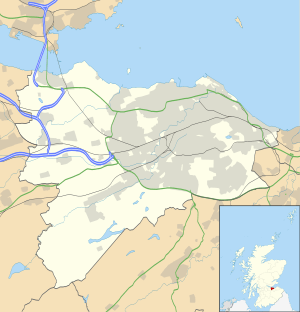
Edinburgh shown within Scotland
|
|||||||||||||||||||||
| Sovereign state | United Kingdom | ||||||||||||||||||||
| Country | Scotland | ||||||||||||||||||||
| Founded | Before 7th century AD | ||||||||||||||||||||
| Burgh charter | 1124 | ||||||||||||||||||||
| City status | 1633 | ||||||||||||||||||||
| Unitary authority | 1 April 1996 | ||||||||||||||||||||
| Administrative HQ | Edinburgh City Chambers | ||||||||||||||||||||
| Government | |||||||||||||||||||||
| • Type | Council | ||||||||||||||||||||
| • Body | The City of Edinburgh Council | ||||||||||||||||||||
| Area | |||||||||||||||||||||
| • Total | 102 sq mi (263 km2) | ||||||||||||||||||||
| Area rank | 23rd | ||||||||||||||||||||
| Population
(2022)
|
|||||||||||||||||||||
| • Total | 514,990 | ||||||||||||||||||||
| • Rank | 2nd | ||||||||||||||||||||
| • Density | 5,060/sq mi (1,955/km2) | ||||||||||||||||||||
| Time zone | UTC+0 (GMT) | ||||||||||||||||||||
| • Summer (DST) | UTC+1 (BST) | ||||||||||||||||||||
| Postcode areas |
EH1–17, EH28–30
|
||||||||||||||||||||
| Dialling codes | 0131 | ||||||||||||||||||||
| ISO 3166 code | GB-EDH | ||||||||||||||||||||
| GSS code | S12000036 | ||||||||||||||||||||
|
|||||||||||||||||||||
Edinburgh is the capital city of Scotland. It is one of Scotland's 32 local government areas. The city is in southeast Scotland. It is bordered by the Firth of Forth to the north and the Pentland Hills to the south.
Edinburgh has been Scotland's capital since at least the 1400s. It is home to the Scottish Government and the Scottish Parliament. The highest courts in Scotland are also here. The Palace of Holyroodhouse is the official home of the King or Queen in Scotland.
The city is famous for its education, especially in medicine, law, and science. The University of Edinburgh, started in 1582, is one of the world's top research universities. Edinburgh is also a major financial centre. It is the second largest in the United Kingdom.
Edinburgh is a big cultural hub. It has places like the National Museum of Scotland and the Scottish National Gallery. The city is also known for the Edinburgh International Festival and the Edinburgh Festival Fringe. The Fringe is the world's largest yearly arts festival.
Historic places in Edinburgh include Edinburgh Castle and the Palace of Holyroodhouse. The Old Town and New Town are a UNESCO World Heritage Site. This means they are very important and protected. Edinburgh is the UK's second most visited city for tourists.
Contents
- What's in a Name? The Story of Edinburgh's Name
- Edinburgh's Fun Nicknames
- A Look Back: Edinburgh's History
- Exploring Edinburgh's Geography
- Edinburgh's Weather
- Who Lives in Edinburgh?
- Faith and Beliefs in Edinburgh
- Edinburgh's Economy: How the City Makes Money
- Edinburgh's Vibrant Culture
- Getting Around Edinburgh: Transport
- Learning in Edinburgh: Education
- Staying Healthy: Healthcare in Edinburgh
- Sports in Edinburgh
- Famous People from Edinburgh
- Edinburgh's Global Connections
- See also
What's in a Name? The Story of Edinburgh's Name
The name "Edinburgh" comes from "Edin." This word comes from Eidyn, which was the name for the area in an old Celtic language called Cumbric. The meaning of Eidyn is not known.
The area of Eidyn had a strong fort called Din Eidyn. This fort was likely on Castle Rock, where Edinburgh Castle stands today.
Around 638 AD, a king named Oswald attacked Din Eidyn. This led to a period of English influence in southeast Scotland. Over time, the language changed from Cumbric to Old English and then to Scots. The Celtic word din (meaning fort) was replaced by burh (also meaning fort), which gave us "Edinburgh." In Scottish Gaelic, the city is called Dùn Èideann.
Edinburgh's Fun Nicknames
Edinburgh has many nicknames!
Why is Edinburgh called 'Auld Reekie'?
One popular nickname is Auld Reekie, which means "Old Smoky" in Scots. People used to call it this because of the smoke that hung over the Old Town from all the chimneys. You could see this smoke from far away in the countryside.
A writer named Walter Scott once wrote that you could see the smoke hovering over Edinburgh from 20 miles away!
Why is Edinburgh called 'Athens of the North'?
Since the early 1800s, Edinburgh has also been called the Athens of the North. This is because the city looks a bit like Athens in Greece. Edinburgh's Castle Rock looks like the Acropolis in Athens. Also, many buildings in Edinburgh's New Town have a similar style to ancient Greek buildings.
Both cities also had flat land leading to a port a few miles away. Edinburgh was also a big centre for new ideas and learning during the Scottish Enlightenment. This was like how ancient Athens was a centre for philosophy.
Other Nicknames for Edinburgh
- Edina is a poetic name used by Scottish poets in the late 1700s.
- Embra or Embro are informal, friendly names for the city.
- The writer Ben Jonson called Edinburgh "Britaine's other eye."
- Robert Louis Stevenson said Edinburgh "is what Paris ought to be."
A Look Back: Edinburgh's History

How Edinburgh Began
People have lived in the Edinburgh area for a very long time. The earliest signs of people are from about 8500 BC at a place called Cramond. Later, people lived on Castle Rock and Arthur's Seat.
When the Romans came to Scotland, they found a Celtic tribe called the Votadini. The fort on Castle Rock, Din Eidyn, became an important place for them.
Around 638 AD, the Angles took control of the area. Later, around 950 AD, the Scots took over. Edinburgh has been part of Scotland ever since.
King David I officially made Edinburgh a royal town in the early 1100s. The city grew and became the main town of Scotland by the 14th century.
In 1582, King James VI allowed Edinburgh to start a university. This university, now called the University of Edinburgh, helped the city become a major centre for learning.
Edinburgh in the 1600s
In 1603, King James VI of Scotland also became King of England. This joined the two crowns, but Scotland remained a separate kingdom.
In the 1600s, Edinburgh was still surrounded by its city walls. Because of this, as more people moved in, buildings had to be built very tall. Some buildings were 11 storeys or more! These were like early skyscrapers.
Edinburgh in the 1700s
In 1707, Scotland and England officially joined to form the Kingdom of Great Britain. This meant the Scottish Parliament moved to London. Many Scots were against this.
By the early 1700s, Edinburgh was very crowded. Different social classes lived in the same buildings. Shopkeepers might live on lower floors, while wealthier people lived in the middle.
After a rebellion in 1745, the city council decided to expand Edinburgh. They wanted to make it more like London. They planned a "New Town" to the north of the castle. This New Town had a very organised, grid-like layout. Streets were named after the royal family, like George Street and Queen Street.
This period was also the time of the Scottish Enlightenment. Smart thinkers like David Hume and Adam Smith lived in Edinburgh. The city became a major place for new ideas and learning. This is why it earned the nickname "Athens of the North."
Edinburgh in the 1800s and 1900s

Edinburgh became an industrial city in the 1800s. Its traditional industries like printing and brewing grew. New industries like rubber and engineering also started. By 1821, Glasgow became Scotland's largest city, taking over from Edinburgh.
The Old Town became very crowded and run-down. Improvements were made in the late 1800s and early 1900s. In the 1960s and 70s, more old buildings were cleared to make way for new ones.
Since the 1990s, a new financial area has grown west of the castle. This has helped Edinburgh stay the second largest financial centre in the UK after London.
In 1998, the Scottish Parliament was brought back to Scotland. It is now based in Edinburgh. This means Scotland has its own government again, responsible for many things like education and health.
Edinburgh in the 2000s
In 2023, Edinburgh became the first capital city in Europe to sign the global Plant Based Treaty. This treaty aims to promote plant-based eating to help the environment.
Exploring Edinburgh's Geography
Where is Edinburgh Located?
Edinburgh is in Scotland's Central Belt. It sits on the southern shore of the Firth of Forth. The city centre is about 2.5 miles (4 km) southwest of the coast.
The city is often said to be built on seven hills. These include Calton Hill, Corstorphine Hill, and Arthur's Seat. This is why some people compare it to Rome, which is also built on seven hills.
Edinburgh's Unique Landscape
Edinburgh's landscape was shaped by ancient volcanoes and glaciers. Castle Rock, where the castle stands, is a tough volcanic rock. Glaciers carved out valleys around it, creating the distinctive "crag and tail" shape. The Nor Loch, now drained, used to fill a valley on the north side of the rock.
Arthur's Seat is also the remains of an old volcano. Glaciers wore it down, leaving behind the rocky Salisbury Crags.
The Water of Leith river flows through the city. It starts in the Pentland Hills and empties into the Firth of Forth. The Water of Leith Walkway is a path that follows the river for about 12 miles (19.6 km).
Edinburgh is surrounded by a "green belt." This is a protected area of land that stops the city from spreading too much. It also helps keep green spaces around the city.
Different Areas of Edinburgh
Edinburgh has many different areas. Some used to be separate towns and villages before the city grew. Many homes in areas like Dalry are in large buildings called tenements, where many families live. In the south and west, you find more detached houses.
The heart of Edinburgh is split by Princes Street Gardens. To the south, you see Edinburgh Castle and the Old Town. To the north are Princes Street and the New Town.
Old Town and New Town: A UNESCO World Heritage Site
Edinburgh's Old and New Towns are a UNESCO World Heritage Site. This means they are recognised as being very important globally.
The Old Town has a medieval street plan. The castle sits on a rocky hill. The Royal Mile runs down from the castle to Holyrood Palace. Small streets called closes or wynds branch off the Royal Mile. Because space was limited, people built tall "high rise" buildings called lands in the Old Town. Some were 10 or 11 storeys high!
The New Town was built in the 1700s to solve the problem of overcrowding. A young architect named James Craig won a competition to design it in 1766. His plan was a neat, organised grid. George Street is the main street, with Princes Street and Queen Street on either side. Princes Street is now Edinburgh's main shopping street.
The area between the Old and New Towns used to be a dirty loch (lake) called the Nor Loch. It was drained in the 1820s. Soil from building the New Town was dumped there to create The Mound, which connects the two parts of the city.
Southside and Leith
The Southside is a residential area popular with families and students. The University of Edinburgh and Napier University have campuses here.
Leith was Edinburgh's historic port. It has its own unique feel. It joined Edinburgh in 1920. The Edinburgh Waterfront project has changed old dock areas into new homes and shops. This has helped the area become lively again.
Edinburgh's Weather
Edinburgh has a cool, mild climate. Even though it's quite far north, it's not as cold as places like Moscow. Being close to the sea helps keep temperatures steady. Winters are rarely freezing, and summers are mild, usually not going above 22°C (72°F).
Edinburgh is known as "the windy city." The wind usually comes from the southwest. Rain falls fairly evenly throughout the year. Sometimes, a thick coastal fog called "haar" can roll in from the east.
Who Lives in Edinburgh?
Edinburgh has a population of about 514,543 people as of 2022. It has a lot of young adults, especially those in their 20s and 30s.
Many people in Edinburgh were born outside the UK. In 2022, about 23.5% of the population was born overseas. The largest groups of people born outside the UK come from Poland, India, and China.
Faith and Beliefs in Edinburgh
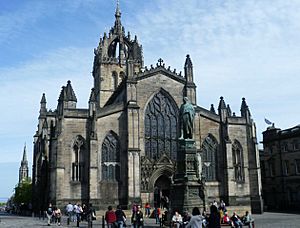
Edinburgh has many different places of worship. The Church of Scotland has many churches, with St Giles' Cathedral being the most famous. St Giles is the patron saint of Edinburgh.
The Roman Catholic Archdiocese of St Andrews and Edinburgh has many parishes in the city. There are also churches for the Scottish Episcopal Church and various Orthodox Christian groups.
Muslims have several places of worship, including the large Edinburgh Central Mosque. There is also a Jewish community with a synagogue. Sikh and Hindu temples are located in Leith. The city also has Buddhist centres and other faith groups.
Edinburgh's Economy: How the City Makes Money
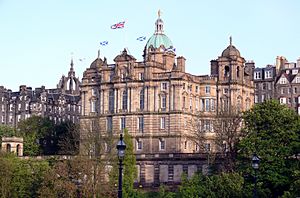
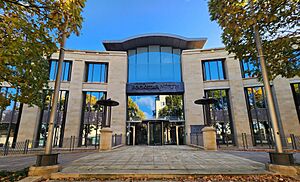
Edinburgh has a very strong economy. It's one of the best in the UK outside of London. Many people in Edinburgh have university degrees or professional qualifications.
Because Edinburgh is the centre of Scotland's government and legal system, the public sector is a big part of its economy. Many government offices are in the city.
Other important industries include education, health, and scientific services. Edinburgh is also a major financial centre, second only to London in the UK.
Tourism is very important too. As a World Heritage Site, Edinburgh attracts millions of visitors each year. They come to see places like Edinburgh Castle and the Old and New Towns. The Edinburgh Festivals in August bring in many tourists and a lot of money for the city.
Edinburgh's Vibrant Culture
Festivals and Celebrations: A City of Fun!
Edinburgh is famous for its festivals, especially in summer.
Edinburgh's Summer Festivals
Every year, from late July to early September, Edinburgh hosts a series of festivals. The most famous are:
- The Edinburgh Festival Fringe: The world's largest performing arts festival. In 2017, almost 3,400 different shows were put on! Many famous comedians got their start here.
- The Edinburgh International Festival: This festival features high-quality theatre and classical music from around the world.
- The Edinburgh Military Tattoo: This amazing show takes place on the Castle Esplanade. It features pipe bands and military bands from all over the world, ending with fireworks.
Many other festivals happen throughout the year, like the Edinburgh International Film Festival and the Edinburgh International Science Festival.
Hogmanay: New Year's Eve in Edinburgh
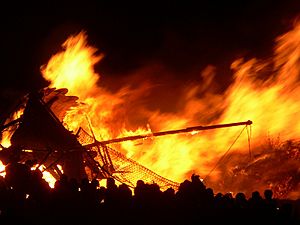
Edinburgh's Hogmanay (New Year's Eve) celebration is huge! It used to be a street party, but now it's officially organised in Princes Street. Over 100,000 people can attend the main street party. Hogmanay lasts for four days with parades, concerts, and fireworks. People come from all over the world to celebrate.
Beltane Fire Festival
On the night of April 30th, the Beltane Fire Festival takes place on Calton Hill. It's a procession and celebration inspired by ancient spring traditions.
Music, Theatre, and Film in Edinburgh

Edinburgh has many theatres and music venues. The Royal Lyceum Theatre has its own company. Larger shows are staged at the King's Theatre, Edinburgh Festival Theatre, and Edinburgh Playhouse. The Traverse Theatre shows more modern plays.
The Usher Hall is the main place for classical music concerts. It even hosted the Eurovision Song Contest 1972. Other venues include The Hub and the Queen's Hall.
Edinburgh has cinemas like The Cameo and the Dominion Cinema. The city also has a lively popular music scene. Big concerts happen at Murrayfield Stadium. Many pubs are known for live folk music.
Museums, Libraries, and Galleries
Edinburgh has many museums and libraries. These include:
- The National Museum of Scotland
- The National Library of Scotland
- The National War Museum
- The Museum of Edinburgh
- The Museum of Childhood
- Dynamic Earth, which explores the story of our planet.
Edinburgh Zoo is a popular attraction on Corstorphine Hill. It used to be home to two giant pandas! The Royal Yacht Britannia, a former royal ship, is now a visitor attraction in Leith.
Edinburgh has three National Galleries of Art. The Scottish National Gallery on The Mound shows the national art collection. The Scottish National Gallery of Modern Art shows modern art. The Scottish National Portrait Gallery focuses on portraits and photos.
Getting Around Edinburgh: Transport
Air Travel
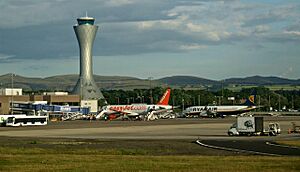
Edinburgh Airport is Scotland's busiest airport. It is the main international airport for the capital. In 2019, over 14.7 million passengers used it. There are plans to expand the airport in the future.
Buses
Most travel in Edinburgh is by bus. Lothian Buses runs most of the city's bus services. Buses to other towns leave from Edinburgh Bus Station. Lothian Buses also runs night buses and airport buses. To help with traffic, Edinburgh has six park & ride sites on the edge of the city.
Trains
Edinburgh Waverley is Scotland's second busiest train station. It is a major hub for trains from London and for services within Scotland. Haymarket station is another important commuter stop.
Trams
Edinburgh Trams started running on May 31, 2014. The city used to have trams, but they stopped in 1956. The tram line runs from Edinburgh Airport to Newhaven. There are plans to extend the tram network even further in the future.
Learning in Edinburgh: Education
Schools in Edinburgh
The City of Edinburgh Council runs many schools. There are 18 nursery schools, 94 primary schools, and 23 secondary schools.
Edinburgh is home to The Royal High School, one of the oldest schools in the country. The city also has several private schools, like Fettes College and George Heriot's School.
Colleges and Universities
Edinburgh has three universities:
- The University of Edinburgh: Started in 1583, it's one of Scotland's oldest universities. It's known for its research and is ranked very highly worldwide.
- Heriot-Watt University: Founded in 1821, it became a university in 1966. It's known for its strong research and has campuses in other countries.
- Edinburgh Napier University: This university started as a college and became a university in 1992.
Edinburgh also has Edinburgh College, which offers further education. Other important institutions include the Royal College of Surgeons of Edinburgh and the Royal College of Physicians of Edinburgh.
Staying Healthy: Healthcare in Edinburgh
The main hospitals in Edinburgh are the Royal Infirmary of Edinburgh and the Western General Hospital. The Royal Infirmary includes the University of Edinburgh Medical School. The Western General has a large cancer treatment centre.
The Royal Edinburgh Hospital helps with mental health. The Royal Hospital for Children and Young People is a special hospital for children. There are also private hospitals in the city.
Sports in Edinburgh
Football (Soccer)
Men's Football
Edinburgh has four professional football clubs:
- Heart of Midlothian (Hearts)
- Hibernian (Hibs)
- Edinburgh City
- Spartans
Hearts and Hibs are big rivals, and their matches are called the Edinburgh derby. Both teams play in the top Scottish league. The Scottish national team sometimes plays at Easter Road or Tynecastle.
Women's Football
In women's football, Hearts, Hibs, and Spartans play in the top Scottish league.
Rugby
The Scotland national rugby union team plays at Murrayfield Stadium. This is Scotland's largest stadium. The professional Edinburgh Rugby team also plays here. Murrayfield is also used for music concerts.
The first international rugby game ever was played in Edinburgh in 1871, between Scotland and England.
Other Sports
The Scottish cricket team plays its home matches at The Grange cricket club. Edinburgh also has an ice hockey team, the Edinburgh Capitals. There's a special building for curling next to the ice rink.
Edinburgh has hosted big sports events like the 1970 British Commonwealth Games and the 1986 Commonwealth Games. The Royal Commonwealth Pool was built for these games.
The Edinburgh Marathon is held every year. It's known as one of the fastest marathons in the UK.
Famous People from Edinburgh
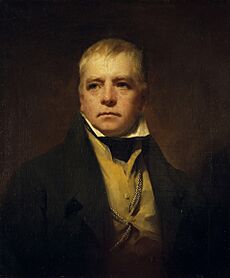

Edinburgh has a long history of famous writers, scientists, and artists. It was named the first UNESCO City of Literature in 2004.
Writers and Thinkers
- Adam Smith: An economist who wrote The Wealth of Nations.
- Sir Walter Scott: A famous writer of historical novels like Ivanhoe.
- Robert Louis Stevenson: Wrote Treasure Island and Strange Case of Dr Jekyll and Mr Hyde.
- Sir Arthur Conan Doyle: The creator of Sherlock Holmes.
- Muriel Spark: Author of The Prime of Miss Jean Brodie.
- Irvine Welsh: Wrote Trainspotting, often set in Edinburgh.
- Ian Rankin: Author of the Inspector Rebus crime thrillers.
- J. K. Rowling: Wrote much of her first Harry Potter book in Edinburgh.
Scientists and Inventors
- John Napier: Invented logarithms.
- James Clerk Maxwell: A key figure in the study of electromagnetism.
- Alexander Graham Bell: The inventor of the telephone.
- James Hutton: Known as the "Father of Geology."
- Joseph Black: Discovered magnesium and carbon dioxide.
- Peter Higgs: A Nobel Prize winner in physics, known for the Higgs boson.
Artists and Performers
- Sir Sean Connery: The first actor to play James Bond.
- Ronnie Corbett: A famous comedian.
- Sir Henry Raeburn: A well-known portrait painter.
- Shirley Manson: Lead singer of the band Garbage.
- The Proclaimers: A famous Scottish music duo.
Other Notable People
- Tony Blair: Former British Prime Minister.
- Deacon Brodie: A real-life person who was a respected city official by day and a burglar by night. He inspired a famous story.
- Greyfriars Bobby: A famous dog who supposedly guarded his master's grave for 14 years. His story is a popular part of Edinburgh's history.
Edinburgh's Global Connections
Edinburgh has "twin city" or "sister city" agreements with 14 cities around the world. These links help build friendships and cultural exchange.
| City | Since |
|---|---|
| 1954 | |
| 1958 | |
| 1964 | |
| 1974 | |
| 1977 | |
| 1977 | |
| 1985 | |
| 1985 | |
| 1989 | |
| 1991 | |
| 1994 | |
| 1994 | |
| 1995 | |
| 1995 | |
| 2019 |
See also
 In Spanish: Edimburgo para niños
In Spanish: Edimburgo para niños




